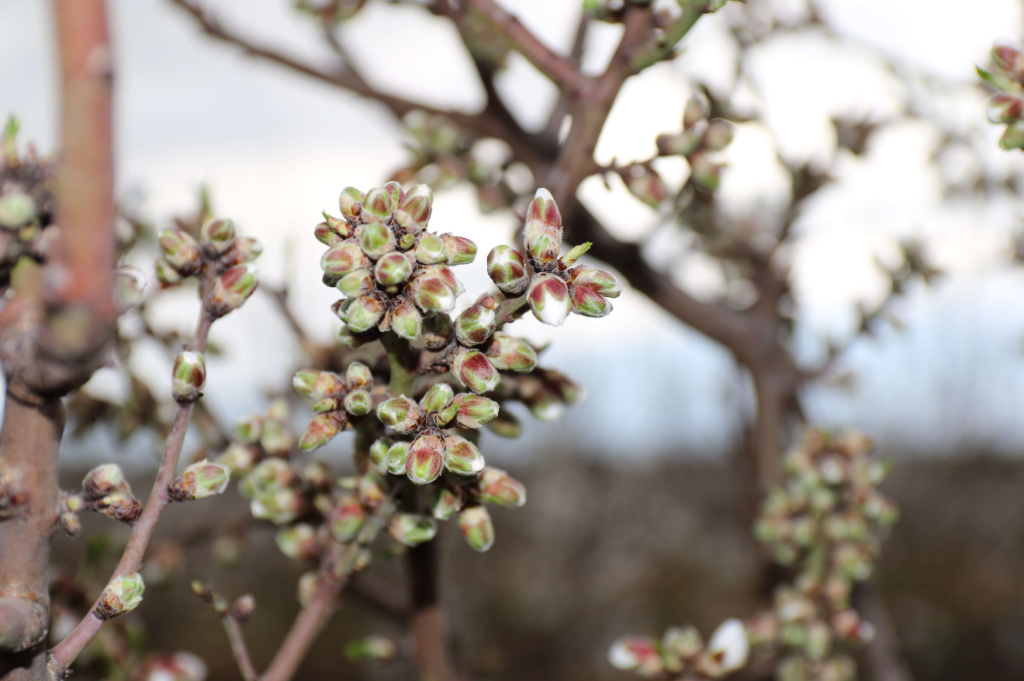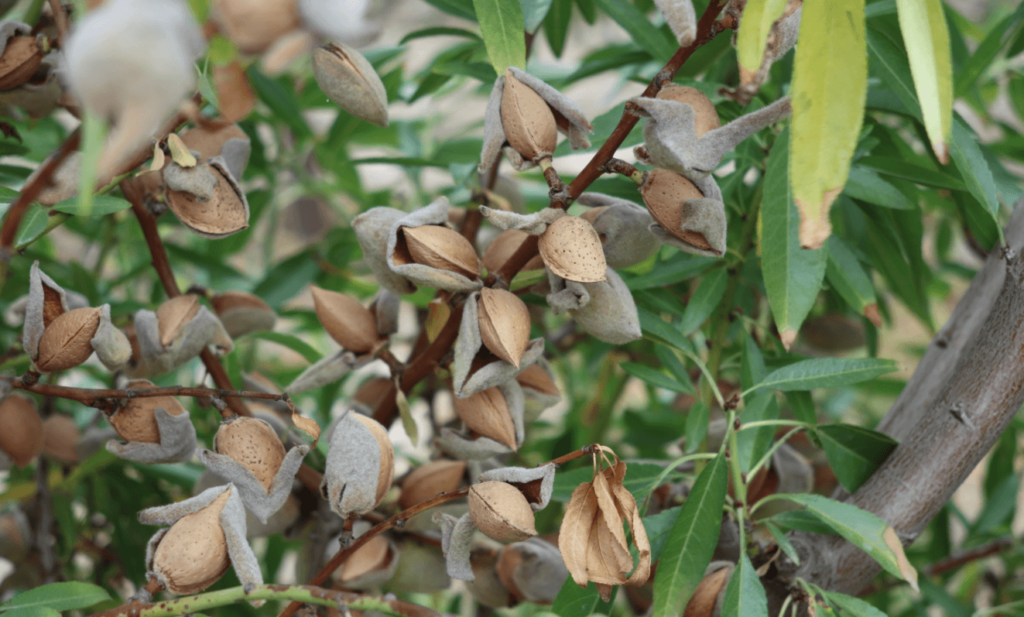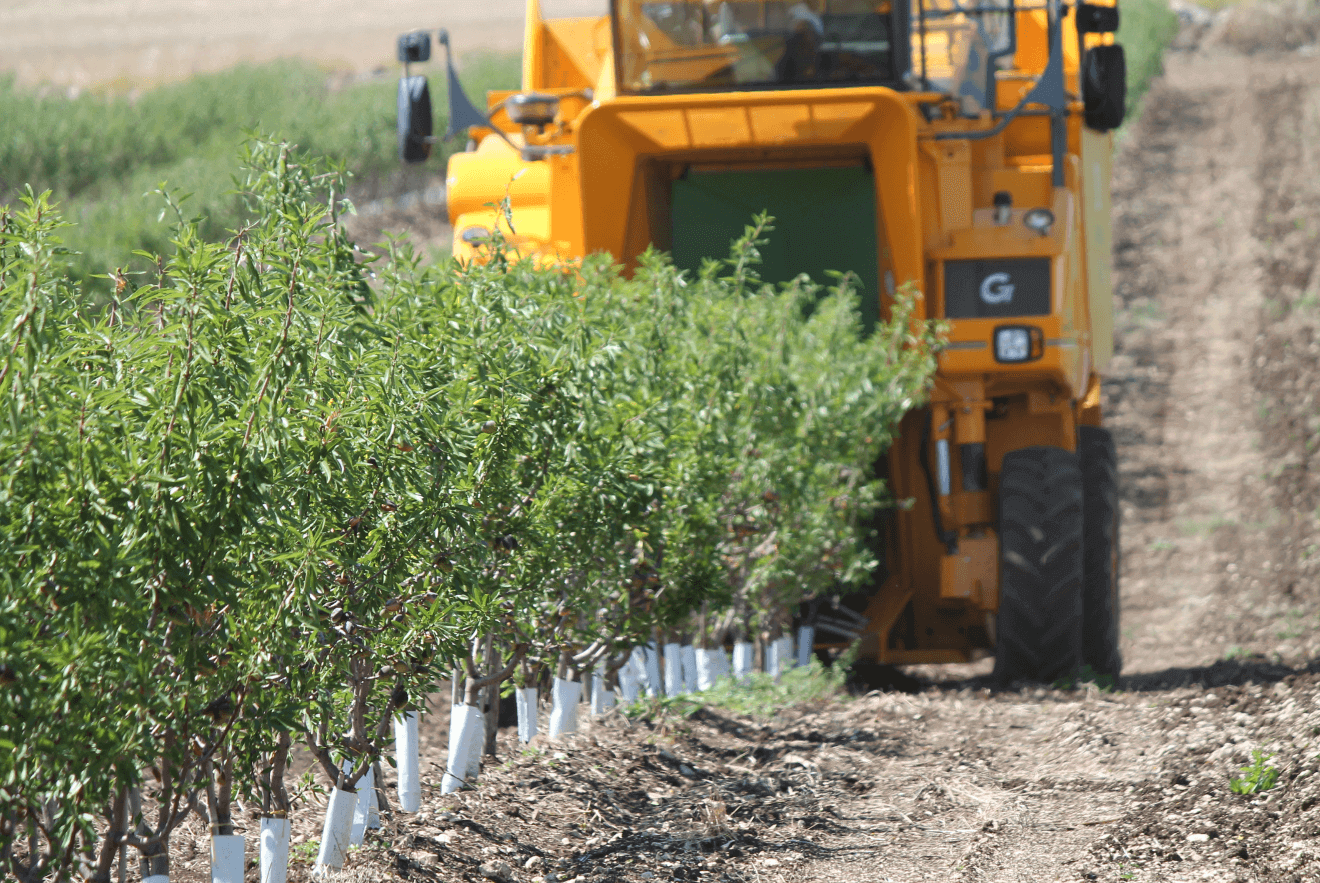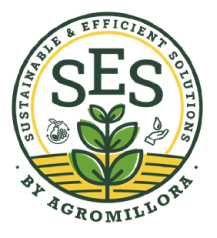Discussion
Fluorescence and SPAD measurements indicated that the state of the trees’ health was adequate for both training systems. Fv/Fm values, which provide an estimation of the maximum quantum efficiency of PSII photochemistry, were indicative of the absence of environmental stress in the trees (Fv/Fm > 0.8) in all cases and in both growing seasons (2018 and 2019), and were similar to those reported by Ranjbarfordoei et al. [36]. Regarding the SPAD measurements, the obtained values were consistent with those of López-López et al. [37] and Erdal et al. [38], and pointed to a constant increase in chlorophyll concentration in leaves during the vegetative cycle, with similar concentrations for both rootstocks (and training systems) and in both growing seasons.
It should be clarified that in this study no adaptation problems of Rootpac-20 to Mediterranean soil conditions were detected, in contrast with the findings of other authors. For instance, Ben Yahmed et al. [39] found Fv/Fm values lower than 0.52 for Rootpac-20 rootstock, suggesting that this rootstock could influence the efficiency of the PSII, and would present a lower tolerance, lower photosynthetic capacity and lower efficiency than GF-677 rootstock. In the same line, Jiménez et al. [40] obtained lower concentrations of chlorophyll for Rootpac-20 than for GF-677.
In relation to the PAR measurements, the obtained average percentages of light interception (73.5% and 54.4% for open-center and SHD, respectively), considering all hours and dates, were in agreement with those reported by Iglesias [9] when comparing different training systems in ‘O’Henry’ peach cultivar. However, in that case, the Double Y, similar to the open-center, intercepted 12% more light (considering all hours along a day) than vertical palmette.
Although it was not possible to compare the two systems in terms of light interception due to its dependence on the geometry of the tree, it is worth noting that parts of the canopy in which the light interception was very high were detected for the open-center training system in both years. Similar results were reported by Iglesias [9] when comparing volumetric and planar training systems in peach, due to the lack of light availability in the inner canopy of the trees, negatively affecting fruit size and fruit color.
For maximum productivity, all foliage must be illuminated above threshold values (in the range 20–30% of incident radiation) for the critical step in the shoot growth–floral initiation–flowering–fruit formation–fruit filling reproductive sequence [32,41]. In view of the tempo-spatial LI data (Figure 3), the open-center trained trees intercepted over 80% of the incident radiation in many areas throughout the day, so the presence of unproductive regions in the tree canopy would be confirmed [41], resulting in an incorrect “light” nutrition of the fruits. As noted by Socias i Company et al. [42], if tree canopies are allowed to become too dense, the inner parts will become so shaded that the leaves can no longer carry on an appreciable amount of photosynthesis. Those interior leaves will then contribute less energy than needed by the fruitwood to which they are attached, and eventually this fruitwood will die.

On the other hand, in the SHD system trees, the walls of the hedgerow would have appropriate LI values all throughout the day. Excessive illumination (with an associated temperature increase that would lower the efficiency of the PSII) was only registered at central hours of the day in some inner regions of the hedgerow.
If LI average values were considered (Figure 4) instead, the LI attained by the SHD system (ca. 55%) would be suffcient: the photosynthetic apparatus of most almond leaves is ‘light-saturated’ at approximately one-half of full sunlight, in such a way that when the light level is approximately one-half the intensity found at solar noon, the rate of photosynthesis is already at maximum [42].
Concerning the productive parameters, a large variability in the number of flowers and set fruits per tree was found, revealing both the heterogeneity between individuals within each system and significant differences from one year to another. In this regard, it is worth noting that almond trees are prone to an alternate-bearing pattern (i.e., previous year fruit bearing has a negative impact on subsequent year flowering), which can be more or less pronounced depending on the specific cultivar. The sensitivity of some varieties depends to a large extent on their productive load [21,43–45].
Maximization of the yield per tree can have a negative impact on the distribution of nutrients among the different parts of the tree, due to imbalances between vegetative growth and floral differentiation [46,47].
In addition, the effect of rainfall on yield cannot be excluded [48]. Leaf nitrogen content (not monitored in this work), has been proposed as a good predictor of yield variation over periods of two or three years by Zarate-Valdez et al. [49]. Fruit set rates in the open-center trees were similar in both growing seasons, and were in good agreement with those reported by Tombesi et al. [50], who studied the setting rate in an open-center plantation with a density similar to that of this study, with a high variability among individuals and between different years, ranging from 18.4 to 36.0%. However, Kodad et al. [51] obtained significantly lower fruit setting rates, with values of 16.6% +/- 6.4% and 17.3% +/- 6.6% in two consecutive years.
In connection with the setting rate in the SHD trees, although it was similar to that of the open-center trees in 2018, in 2019 it was extraordinarily high (over 40%). This can be justified by the very low number of flowers (approximately one third of those in the previous growing season).
This hypothesis would be further supported by the fact that the fruit set per tree were much moresimilar (albeit statistically different). In any case, yield would still be seriously affected, provided that increased relative fruit set when floral densities were low does not compensate for lower numbers of flowers [50]. As noted by Tombesi et al. [50], overall tree yield among years would be more sensitive to total number of flowers on a tree rather than relative fruit set.
The almond fresh fruit yields of complete fruit (with hull) per tree were very similar in the SHD trees, while in the open-center trees there were notable differences between growing seasons (although not statistically significant due to the large IQRs). The same situation was repeated for the almond in shell and the kernel yields per tree, although in the latter case the differences between open-center trees in 2018 and 2019 were statistically significant.
The almond in shell yields per tree in the open-center training system were higher (34.66 and 24.92 kg/tree in 2018 and 2019, respectively) than those reported by Puebla Arias et al. [52,53] (13.0 and 12.78 kg/tree in 2015 and 2016, respectively).
The almond in shell and kernel yields per ha was higher in the open-center than in the SHD
system. In the second, third and fifth year after plantation, kernel yields of 450, 1011 and 1734 kg/ha were estimated for the same orchard [54]. For comparison purposes, for almond trees of the same cultivar (‘Soleta’) and of the same age with an open-center training system, Méndez [55] reported remarkably lower kernel yields, in the 814–1330 kg/ha range (which would also be lower than those obtained for the SHD system in this study). Puebla Arias et al. [52,53] reported kernel yields of 1476 and 1004 kg/ha for trees of approximately the same age and with the same planting density. According to CITA (who developed the cultivar), the potential crop for almond in shell would be 4017 kg/ha and the kernel yield would be 1095 kg/ha (for a 6 m x 7 m spacing) [25].
In relation to the average weight of the almonds in shell, Socias i Company et al. [26] obtained an average weight for ‘Soleta’ cultivar of 3.63 g. In this study, the weights were higher for the open-center training system than for the SHD system in both growing seasons. Whereas in 2019 the almond in shell weights were similar or higher than those reported by Socias i Company, in 2018 the weight for the SHD system was significantly lower. The value obtained in 2019 in open-center trees can be attributed to the lower number of set fruits per tree vs. 2018 (4078 vs. 2286).
Concerning the kernel weight values, in the 0.93–1.18 g/kernel range, they were lower than those reported by Socias i Company et al. [26] (1.27 g/kernel) and Méndez [55] (1.26 g/kernel). Kernel weights were more homogeneous in 2019 than in 2018, and in 2018 the ones from open-center almond trees were significantly larger than those from SHD trees. This could be explained by the effect of rootstock. Lordan et al. [56] reported larger fruit size of ‘Marinada’ and ‘Vairo’ cultivars on GF-677 when compared with Rootpac-20 (both trained in open-center).
The average kernel yield ranged from 29.5 to 38.33%, similar to those reported by Puebla Arias et al. [52,53] (28.35–41.0%) and somewhat higher than that found by Socias i Company et al. [26], who reported yields for ‘Soleta’ cultivar in the 27 to 35% range, by Alonso Segura et al. [25] (30.4%) and by Méndez [55] (32.4% average yield over 6 years). Kernel yields were 2% higher in hedges in both growing seasons. It is worth noting that the highest yield corresponded to the SHD system in 2018, in which the kernel was proportionally larger compared to almond fruit in shell, despite being the one with the lowest weight of the four.
Méndez [55] also observed this same behavior, in which the smallest fruits gave kernel yields higher than those of larger fruits. Nonetheless, the influence of other factors, such as the irrigation rate, cannot be excluded (e.g., Muhammad et al. [57] reported higher kernel weights for higher irrigation rates at similar fruit counts).
The canopy volume in the SHD system was considered fixed in each campaign, since pruning was carried out mechanically. The increase in volume in 2019 (2.25 m3 vs. 2.05 m3) was due to the fact that the cutting height was raised (the width of the hedgerow remained constant). As for the differences in canopy volume in the open-center trees, they were due to differences in pruning, but both they were within usual values [55].
The yield per canopy volume (g with hull/m3 of canopy) in the open-center system was almost half that of SHD system (136 and 128 g/m3 lower in 2018 and 2019, respectively; Table 2). This would be in agreement with Ben Yahmed et al. [39], who found that the use of low vigor rootstocks could be associated to a higher yield efficiency, widely reported in deciduous fruit species. This higher efficiency is important for the future evolution of the SHD system, since it indicates a more efficient use of light, with less shaded areas in the tree and with a canopy volume that is more quickly reached (i.e., it is more precocious). Both seasonal and cumulative yield of kernel per ha were consistently higher in the open-center than in the SHD system (2) because the spacing was close to the optimum in the case of the open-center/GF-677 but not in the SHD/Rootpac-20, as we described below.
With respect to the TCSA, the values for the open-center trees were very similar to those reported by Alonso Segura et al. [25] (326.3 cm2), but the reported yield efficiency, a widely used parameter for other fruit tree species (although not for almond trees), was much higher than those obtained in this study (49.9 g/cm2). The lower TCSA values for the Rootpac-20 rootstock would be in agreement with Ben Yahmed et al. [39] and Lordan et al. [56], who studied the dwarfing effect through the significant slow growth of the trunk, finding that this rootstock would have 35-45% less vigor than GF677.
It is important to point out that in the present trial the first commercial/experimental orchard planted in world in SHD system in almond was analyzed. The spacing was 4 m (inter-row) x 1 m (intra-row), similar to the spacing used in apple orchards, corresponding to the so-called first version or V1. Afterwards, considering the latitude and the optimum ratio inter-row distance vs. tree height (1:1.1), inter-row spacing was first reduced to 3.5 m in a second version (V2), and then further reduced to 3.0 m inter-row spacing in the current version (V3).
In the three versions (V1, V2 and V3), tree height was maintained in around 2.80 m and the intra-row distance in around 1.25 m in V2 and V3. Considering those distances, the mean yields obtained in commercial orchards in the 5th leaf have been 2103 and 2585 kg kernel/ha for V2 and V3, respectively [58].
There are advantages to closer planted trees other than earlier high yields in apple, pear and cherry. In peach, Núñez et al. [34] reported a direct relationship between yields and planting density. Trees planted more densely are smaller and it is easier to fully fill the canopy space. They are less likely to have scaffold breakage problems regardless of how they are trained (e.g., in aforementioned V2 and V3, trees are driven in a hedgerow system with multiple branching from the first year and disorganized canopy based on sequential summer prunings to train them without a central axis).
They are less likely to blow over. If a tree dies, it has less of an impact on yield because there are more trees per acre. In our trial, the more closely planted trees were easier to prune (and may require less pruning) and did not show higher disease pressure.
Taking into consideration the agronomic performance data, and bearing in mind that further research with long-term follow-up is needed to confirm our observations, it may be put forward that the SHD system has a bright future ahead. As explained by Duncan [59] in relation to trials established in 2001 by University of California Cooperative Extension in Stanislaus County, “although some growers may feel that they need to space their trees far apart because of disease concerns, equipment access, ease of drying at harvest, etc. These are all valid reasons for wide spacings, but growers should understand they are sacrificing yield to do this. They may be necessary sacrifices, but they are sacrifices
just the same”.

Conclusions
In the present study, two almond-tree training systems, SHD and open-center, were compared under similar culture conditions during the 2018 and 2019 growing seasons. Fluorescence and SPAD analyses pointed to an adequate general health state of the plants in both systems and to an absence of stress. The analysis of light interception suggested the existence of areas in which light interception was very high for the open-center system, which may present problems with “sink leaves”.
Fruit set rates were similar in both training systems. The average almond in shell weight was significantly higher in the open-center system, while the fruit yield was significantly higher in the SHD one. It follows, then, that the SHD training system would be more efficient, although less productive, than the open-center system. However, the technical evolution of this new almond-tree training system has now led to a remarkable improvement in production efficiency, due to the reduction of inter-row distances and to the optimization of the occupation of the canopy by vegetation through an optimum training with respect to the system evaluated in the present study (V1).
For this reason, and due to the advantages that this system presents in terms of management (reducing labor costs, especially for pruning and harvest), and efficiency on the use of inputs as water and phytosanitary treatments, efforts aimed at improving SHD system seem to be entirely justified.



